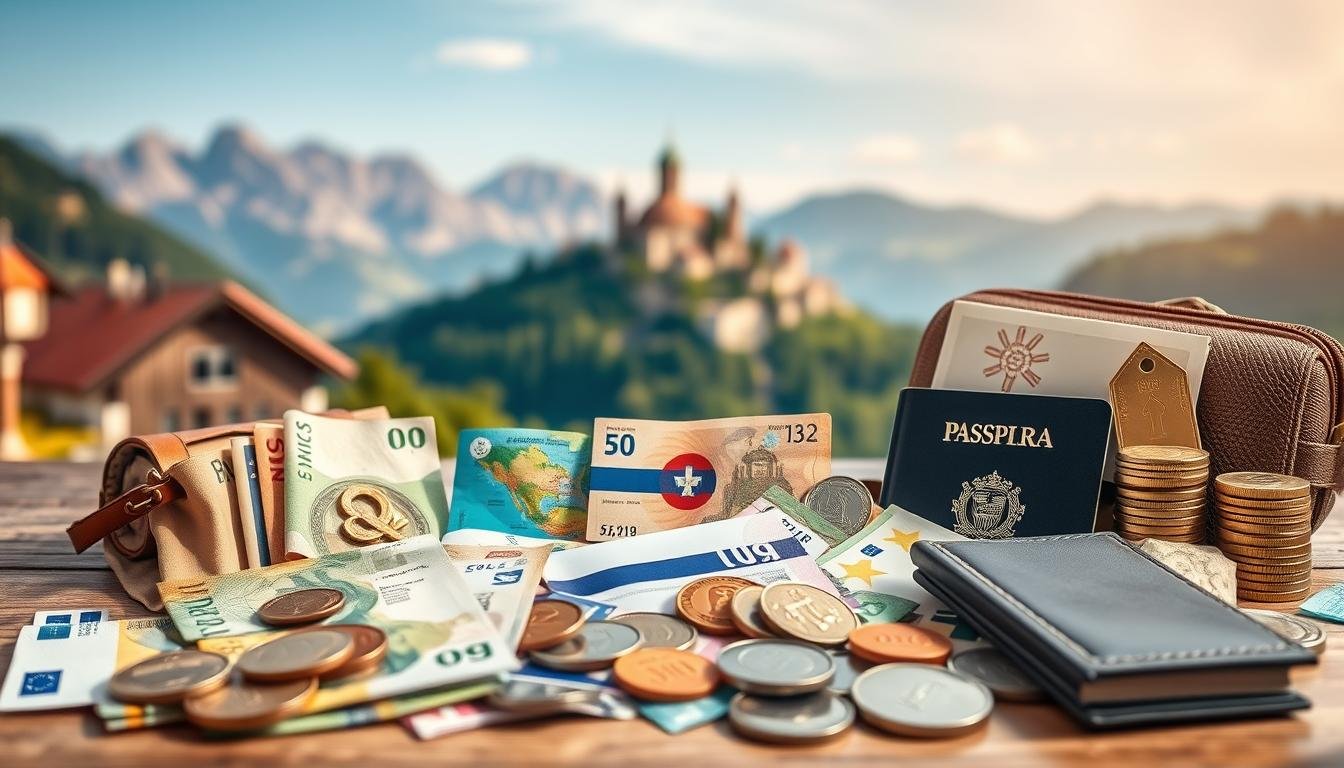✓ Accommodations ✓ Flights ✓ Rental Cars ✓ Tours & Activities
Did you know that the average daily cost for a mid-range trip in this European gem is just €94? That’s less than a fancy dinner in many major cities! Whether you’re planning a short getaway or an extended stay, understanding the local currency and payment systems can make your trip smoother and more budget-friendly.
This country uses the Euro (EUR), which simplifies transactions for many travelers. However, knowing the exchange rate and potential fees is crucial to avoid unnecessary expenses. Using a card wisely can save you money, while cash is still handy for smaller purchases.
In this guide, you’ll learn how to manage your money effectively, secure favorable rates, and avoid hidden charges. Let’s dive into the essentials to help you make the most of your travel budget!
Understanding Slovenia’s Currency and Payment Landscape
Navigating the financial landscape abroad can be tricky, but it doesn’t have to be. The Euro (EUR) is the official currency here, making transactions straightforward for many visitors. However, understanding the nuances of exchange rates and payment methods can save you money and hassle.
An Overview of the Euro
The Euro simplifies transactions across much of Europe, including this destination. Since its adoption, it has become the standard for everyday purchases, from cafes to train tickets. Carrying some cash is still advisable, especially in rural areas where card acceptance may be limited.
How Exchange Rates Affect Your Spending
Exchange rates can significantly impact your travel budget. Banks and currency providers often add markups above the mid-market rate, which can increase costs. Checking live conversion websites before exchanging money ensures you get the best deal. Avoid dynamic currency conversions at ATMs or merchants, as they often include hidden fees.
Using a debit or credit card with no foreign transaction fees is a smart way to manage your travel money. ATMs are widely available, but always check for withdrawal fees to keep costs low. By staying informed, you can eliminate unnecessary expenses and focus on enjoying your trip.
Slovenia: Ultimate Travelers Guide to Currencies & Payments
Avoid unnecessary fees by preparing your travel finances in advance. This guide helps you navigate the financial aspects of your trip, ensuring you save money and avoid stress. From setting up your account to choosing the right travel card, every step is designed to make your journey smoother.
Using a travel card is one of the best ways to minimize fees. Many providers offer benefits like free ATM withdrawals and low foreign transaction fees. By selecting the right card provider, you can keep your spending under control and enjoy your trip without financial worries.
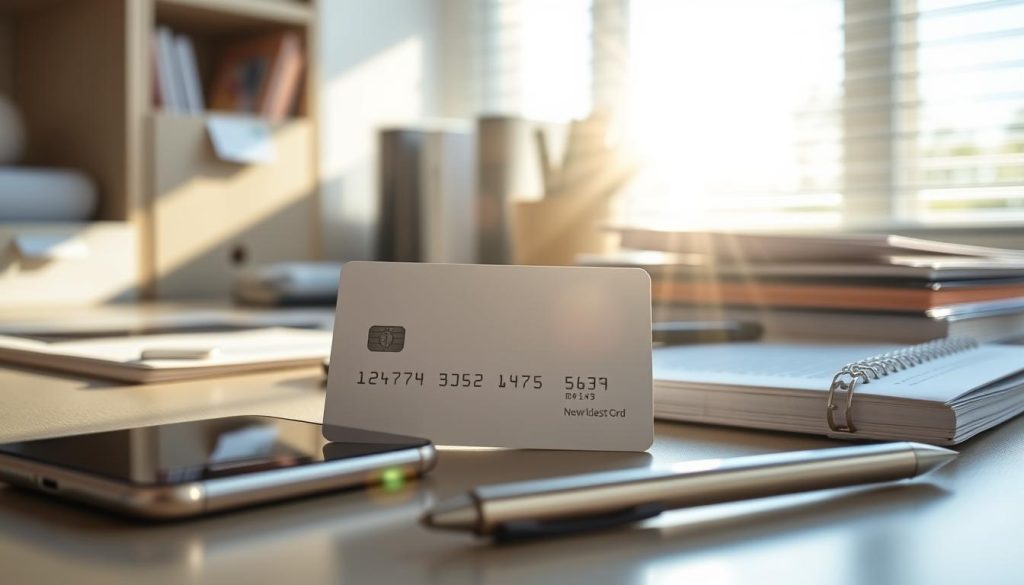
How to Use This Information on Your Trip
Before you leave, set up your account and convert currency in advance. This ensures you get the best rates and avoid last-minute hassles. During your trip, use your travel card for most transactions to save on transaction fees.
Here’s a quick comparison of popular card provider options:
| Provider | Free ATM Withdrawals | Foreign Transaction Fee |
|---|---|---|
| Wise | Yes | 0% |
| Revolut | Yes | 0% |
| Traditional Banks | No | 2-3% |
At airports and hotels, avoid currency exchange desks with high markups. Instead, use ATMs for better rates. Always choose to be charged in the local currency to avoid extra costs. With these tips, you’ll manage your spending effectively and focus on enjoying your trip.
Pre-Travel Currency Exchange Strategies
Planning your currency exchange before your trip can save you both time and money. By converting your USD to EUR in advance, you can avoid last-minute hassles and secure better rates. This approach not only reduces fees but also gives you peace of mind as you prepare for your journey.
Exchanging USD to EUR Before Departure
One of the smartest moves you can make is exchanging your travel money before you leave. Local banks and online platforms often offer more competitive rates than airport or hotel counters. For example, airport exchange desks typically charge markups of 5% to 15%, which can add up quickly.
Using tools like Wise or Revolut can help you lock in a favorable exchange rate. These platforms provide real-time conversion rates and low fees, making them ideal for travelers. By planning ahead, you can avoid the pitfalls of last-minute exchanges and keep more money in your pocket.
Benefits of Securing a Better Exchange Rate Early
Securing a good exchange rate early can significantly impact your travel money. Rates fluctuate daily, and locking in a favorable rate ensures you get the most value for your dollars. This is especially important if you’re converting a large sum.
“Exchanging currency in advance not only saves money but also eliminates the stress of finding a reliable exchange service abroad.”
Additionally, checking both local and online providers allows you to compare rates and choose the best deal. This small step can make a big difference in your overall spending and help you stick to your budget.
Optimizing Your Travel Debit Card and Travel Card Options
Managing your money abroad starts with selecting the best travel card for your needs. With so many options available, it’s essential to compare features and fees to find the right fit. Whether you’re looking for a debit card or a prepaid card, understanding the differences can save you money and stress.
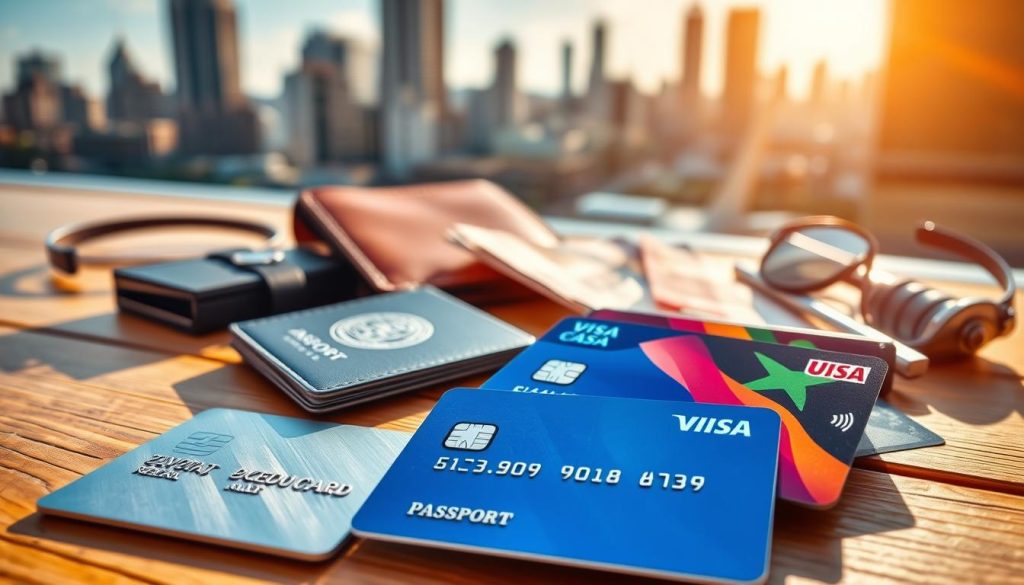
Comparing Providers Like Wise, Revolut, and Others
Popular providers like Wise and Revolut offer competitive features for travelers. Wise provides mid-market exchange rates and supports over 40 currencies, making it a versatile option. Revolut, on the other hand, offers fee-free spending and ATM withdrawals, though limits apply after a certain threshold.
Here’s a quick comparison of key features:
- Wise: Mid-market rates, low fees, and multi-currency support.
- Revolut: No foreign transaction fees, but ATM limits after $1,000.
- Traditional Banks: Often charge 2-3% in foreign fees and ATM withdrawal fees.
Key Features to Look for in a Travel Card
When choosing a travel card, prioritize features that align with your spending habits. Look for low or no foreign transaction fees, easy account management, and global acceptance. Some cards also offer perks like free ATM withdrawals or rewards programs.
Always read the terms and conditions to avoid hidden fees. For example, some providers charge inactivity fees or limit ATM withdrawals. By understanding these details, you can make an informed decision and enjoy a stress-free trip.
Best Practices for ATM Withdrawals in Slovenia
Smart ATM usage can save you money and keep your travel budget intact. Knowing where and how to access your cash efficiently is key to managing your spending while traveling. This section covers tips to avoid unnecessary fees and ensure secure transactions.
Avoiding Costly Airport Exchange Services
Airport exchange desks often charge high fees and offer unfavorable rates. Instead of converting your money at the airport, use reliable ATMs in the city. For example, ATMs operated by major banks like Delavska or Intesa Sao Paolo provide better rates and lower fees.
Always check for additional charges, such as monthly fees or extra fees for currency conversion. By avoiding airport services, you can save a significant amount on your cash withdrawals.
Tips for Safe and Secure ATM Withdrawals
When using ATMs, prioritize those located in well-lit, populated areas or within bank premises. This minimizes risks and ensures your safety. Major cities like Ljubljana have numerous ATMs that accept Visa and Mastercard, making it easy to access your money.
Monitor your withdrawal limits and fees associated with your card. Some ATMs allow up to €500 per transaction, but fees can range from €4 to €5.99. Using a travel debit card with no foreign transaction fees can further reduce costs.
Before your trip, double-check your bank’s policy on international withdrawals. This ensures you’re aware of any potential charges and can plan accordingly. By following these tips, you’ll manage your cash effectively and enjoy a stress-free trip.
Tips for Secure and Cost-Effective Payments Abroad
Making secure and cost-effective payments abroad doesn’t have to be complicated. With the right strategies, you can avoid unnecessary fees and enjoy a stress-free trip. Whether you’re using a travel card or opting for contactless payments, understanding your options is key to saving money.
How to Dodge Foreign Transaction Fees
One of the biggest expenses while traveling is the foreign transaction fee. Many banks charge 2-3% for every international purchase, which can add up quickly. To avoid this, consider using a travel card like Wise or Revolut. These cards often have no foreign transaction fees and offer competitive exchange rates.
Another tip is to always choose to be charged in the local currency. Dynamic currency conversion, where merchants convert the price to your home currency, often includes hidden fees. By selecting the local currency, you’ll avoid these extra costs.
Choosing the Right Payment Method for Everyday Use
When it comes to everyday spending, travel cards are a great option. They’re designed for international use and often come with perks like free ATM withdrawals and low transaction fees. Traditional bank cards, on the other hand, may charge higher fees and offer fewer benefits.
Here’s a quick comparison of popular card providers for international use:
| Provider | Foreign Transaction Fee | ATM Withdrawal Fee |
|---|---|---|
| Wise | 0% | Free up to $6,000/month |
| Revolut | 0% | Free up to $1,000/month |
| Traditional Banks | 2-3% | $5+ per withdrawal |
Using a travel card not only saves you money but also makes managing your spending easier. Many providers offer apps that let you track your expenses in real-time, helping you stick to your budget.
For smaller purchases, contactless payments are a secure and convenient option. They’re widely accepted in most countries and reduce the need to carry cash. Just make sure your card is enabled for international use before you leave.
By planning ahead and choosing the right payment methods, you can avoid unnecessary fees and focus on enjoying your trip. Whether it’s using a travel card or opting for contactless payments, these tips will help you save money and stay secure.
Analyzing Exchange Rates and Currency Conversion Fees
Exchange rates play a crucial role in managing your travel budget effectively. Understanding how they work can save you money and ensure fair transactions. One key concept to grasp is the mid-market rate, which is the real exchange rate used in global financial markets.
Understanding the Mid-Market Rate
The mid-market rate is the average between the buy and sell prices of two currencies. It’s the rate you’ll see on financial news or currency conversion websites. Banks and exchange bureaus often add a markup to this rate, increasing your costs. By knowing the mid-market rate, you can identify these hidden fees and avoid overpaying.
Identifying Hidden Markups on Currency Exchanges
Banks and exchange bureaus profit by marking up the mid-market rate. For example, if the mid-market rate is 1 EUR = 1.10 USD, they might offer 1 EUR = 1.05 USD. This markup can cost you significantly over time. Using online tools like Wise or Revolut helps you track real-time rates and compare them to what you’re quoted.
Here’s a quick comparison of exchange rates and fees:
| Provider | Markup Over Mid-Market Rate | Additional Fees |
|---|---|---|
| Traditional Banks | 2-5% | $5+ per transaction |
| Airport Exchange Desks | 5-15% | High service fees |
| Wise | 0% | Low transparent fees |
Always compare the quoted rate to the mid-market rate before exchanging your money. This simple step can save you hundreds of dollars. For instance, converting $1,000 at a 5% markup costs you $50 extra. By choosing a transparent provider, you keep more of your balance for your trip.
Transparency in currency conversion fees is essential. Many providers hide fees in the exchange rate, making it hard to know the true cost. Tools like Wise offer clear breakdowns, ensuring you get the best deal. Regularly checking rates during your travels also helps you stay informed and avoid surprises.
By understanding the mid-market rate and avoiding hidden markups, you can manage your travel money more effectively. This knowledge not only saves you money but also gives you peace of mind during your trip.
Planning Your Budget for Slovenia: Daily Costs and More
Understanding the average costs of travel essentials helps you budget smarter. Whether you’re a budget-conscious traveler or prefer a more luxurious experience, knowing what to expect can make your trip smoother. Let’s break down the key expenses you’ll encounter and how to manage them effectively.
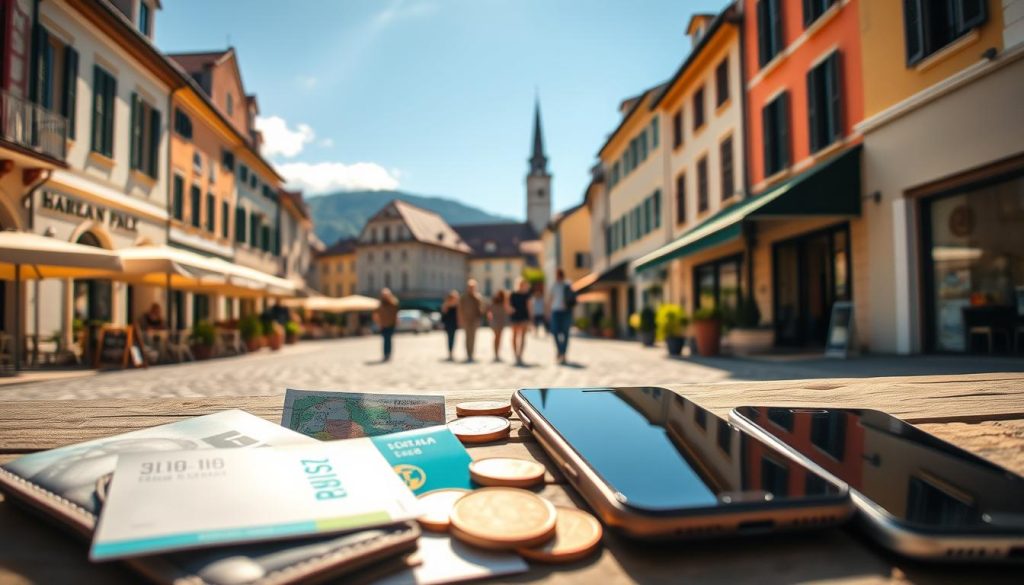
Estimating Daily Expenses for Accommodation and Food
Accommodation and meals are two of the biggest expenses during your trip. For a mid-range hotel, expect to pay around €40-60 per night. Budget options like hostels can cost as little as €15-20, while luxury hotels may exceed €100.
When it comes to food, a meal at a mid-range restaurant typically costs €10-15. Street food and local markets offer cheaper alternatives, with prices starting at €5. Planning your meals can help you save significantly on your daily cost.
Budgeting for Transportation and Attractions
Local transport is affordable, with a one-way ticket costing around €1.30. If you plan to explore extensively, consider a daily pass for €4-5. Renting a car starts at €20 per day, but fuel and insurance add to the price.
Attractions like Lake Bled or Postojna Cave often charge entrance fees. Researching discounts or combo tickets can help you save. For example, some museums offer free entry on specific days.
“A well-planned budget ensures you enjoy your trip without worrying about overspending.”
Here’s a quick breakdown of average daily costs:
| Category | Budget | Mid-Range | Luxury |
|---|---|---|---|
| Accommodation | €15-20 | €40-60 | €100+ |
| Meals | €10-15 | €20-30 | €50+ |
| Transport | €5 | €10 | €20+ |
Having both cash and card options is essential. While cards are widely accepted, smaller vendors and rural areas may prefer cash. Always carry some euros for convenience.
By monitoring your daily spending, you can adjust your budget as needed. Apps like Revolut or Wise help track expenses in real-time, ensuring you stay on track.
With these tips, you’ll manage your travel money effectively and enjoy a stress-free trip. Whether you’re exploring cities or nature, smart budgeting lets you focus on the experience.
Navigating Payment Options in Tourist Areas
Choosing the right payment method can make your trip smoother and more enjoyable. While many establishments accept cards, some smaller vendors or tipping scenarios require cash. Understanding when to use each option ensures you’re prepared for any situation.
When to Use Cash Versus Card
Using cash is often preferred in smaller shops, taxis, and for tipping. These scenarios typically involve lower transaction amounts, making cash more convenient and widely accepted. For example, street vendors or rural markets may not have card terminals.
On the other hand, cards are ideal for larger purchases, hotels, and restaurants. They offer security and convenience, especially when traveling with limited cash. Many tourist areas have high card acceptance rates, making it easy to rely on your card for most transactions.
| Payment Method | Best For | Drawbacks |
|---|---|---|
| Cash | Small vendors, taxis, tipping | Risk of loss or theft |
| Card | Hotels, restaurants, large purchases | Potential foreign transaction fees |
To minimize fees, use a travel card with no foreign transaction charges. Providers like Wise and Revolut offer competitive rates and low fees, making them ideal for international use. Always choose to be charged in the local currency to avoid dynamic currency conversion fees.
“Carrying a mix of cash and card ensures you’re prepared for any payment scenario during your trip.”
For safe cash withdrawals, use ATMs located in well-lit, populated areas. Avoid airport exchange desks, as they often charge high fees. Major banks like Delavska or Intesa Sao Paolo offer better rates and lower withdrawal fees.
By planning ahead and understanding your payment options, you can manage your travel budget effectively. Whether it’s using cash for small purchases or relying on your card for convenience, these tips will help you navigate payments with ease.
Using a Euro Card for Hassle-Free Spending
Managing your finances while traveling can be stress-free with the right tools. A Euro card is one of the best ways to simplify your spending and avoid unnecessary fees. By holding a balance in EUR, you can lock in favorable exchange rates and enjoy smoother transactions.
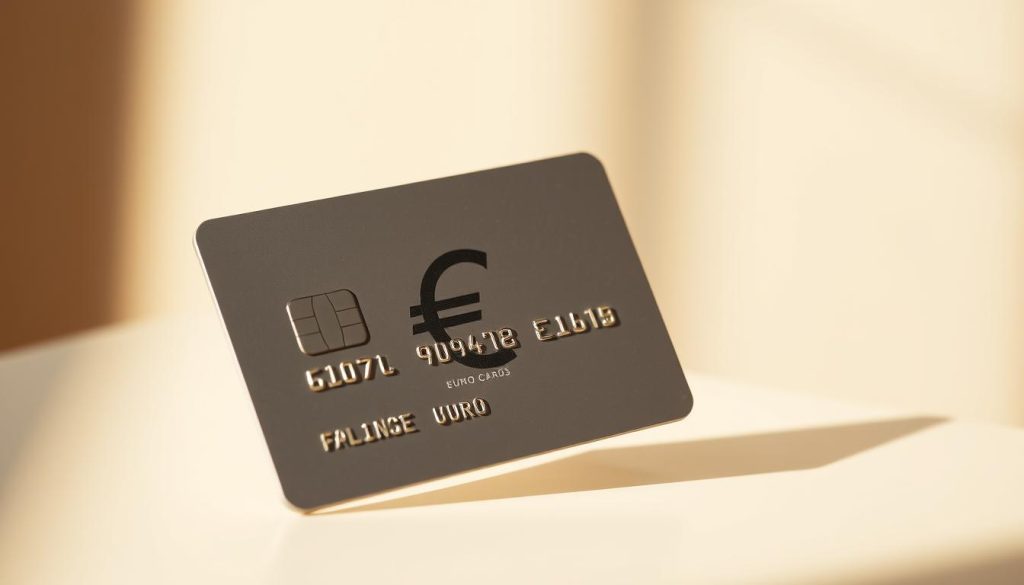
Benefits of Holding a Euro Balance
One of the key advantages of a Euro card is the ability to hold a balance in EUR. This eliminates the need for frequent currency conversions, saving you money on fees. For example, if you’re traveling across multiple Eurozone countries, a single account in EUR ensures consistent spending power.
Another benefit is the security it offers. Unlike cash, a debit card can be easily blocked if lost or stolen. Many card providers also offer mobile apps for real-time tracking of your account, making it easy to manage your travel debit on the go.
How to Set Up and Manage Your Euro Account
Setting up a Euro account is straightforward. Providers like Wise allow you to open an account online and convert your currency at competitive rates. Once set up, you can load your card with EUR and start spending immediately.
Managing your account is equally simple. Most providers offer apps that let you track your balance, view transactions, and even set spending limits. This level of control ensures you stay within your budget while traveling.
“A Euro card not only saves you money but also gives you peace of mind during your trip.”
When choosing a card provider, look for fee transparency and competitive exchange rates. Some providers charge hidden fees or mark up the exchange rate, so it’s essential to compare options. By doing your research, you can find a card that meets your needs and keeps your travel debit costs low.
In summary, a Euro card is a smart choice for hassle-free spending abroad. It simplifies transactions, saves you money, and offers added security. Whether you’re exploring cities or rural areas, having a EUR balance ensures you’re always prepared.
Traveler Insights: Real-World Money Management Tips
Smart money management can transform your travel experience. Whether you’re exploring cities or countryside, practical tips from seasoned travelers can help you save and spend wisely. Here’s how to make the most of your budget while enjoying every moment.
Smart Spending Habits on the Ground
Tracking your daily spending is one of the best ways to stay within budget. Use apps like Revolut or Wise to monitor expenses in real-time. These tools also help you avoid unnecessary fees by offering transparent exchange rates.
Another tip is to prioritize cash for small purchases and cards for larger ones. This approach minimizes transaction fees and ensures you’re prepared for any payment scenario. Always choose to be charged in the local currency to avoid dynamic currency conversion fees.
- Set a daily spending limit and stick to it.
- Use a travel card with no foreign transaction fees.
- Compare prices before making purchases, especially for souvenirs.
Local Money-Saving Hacks
Exploring like a local can save you money and uncover hidden gems. For example, street food and local markets often offer delicious meals at a fraction of restaurant prices. Apps like Too Good To Go can help you find discounted meals from local vendors.
Public transport is another affordable way to get around. Consider purchasing daily or weekly passes to save on fares. Many cities also offer free walking tours, which are a great way to explore while staying on budget.
“Using digital tools and local knowledge can help you save significantly during your trip.”
Here’s a quick guide to saving locally:
| Category | Tip |
|---|---|
| Food | Opt for street food or local markets. |
| Transport | Use public transport passes. |
| Attractions | Look for free or discounted entry days. |
By adopting these habits and hacks, you’ll manage your travel money effectively and enjoy a stress-free journey. Whether it’s using a travel card or embracing local discounts, these tips will help you make the most of your trip.
Minimizing Costs: Avoiding Hidden Fees and Extra Charges
Hidden fees can quickly add up, but with the right knowledge, you can avoid them. Whether it’s an unexpected ATM charge or a sneaky transaction fee, these costs can eat into your travel budget. By planning ahead and staying informed, you can save money and focus on enjoying your trip.
Spotting Unfair ATM Withdrawal Fees
ATMs are convenient, but they can come with hidden costs. Some charge high withdrawal fees, especially at airports or tourist hotspots. Always check the fee disclosure on the ATM screen before completing your transaction. Using ATMs affiliated with major banks often results in lower fees.
Here’s a quick comparison of ATM fees from different providers:
| Provider | Withdrawal Fee | Foreign Transaction Fee |
|---|---|---|
| Major Banks | €1.5-€4 | 1-3% |
| Airport ATMs | €5+ | 3-5% |
| Travel Cards | Free up to €1,000 | 0% |
To avoid extra charges, withdraw larger amounts less frequently. This reduces the number of transactions and saves on fees. Always choose to be charged in the local currency to avoid dynamic currency conversion fees.
Reviewing Terms for Transparent Payment Options
Not all payment providers are created equal. Some include hidden fees in their terms and conditions. Before selecting a card or service, read the fine print carefully. Look for details about foreign transaction fees, inactivity fees, and ATM withdrawal limits.
Here’s a checklist to ensure your transaction terms are transparent:
- No foreign transaction fees.
- Low or no ATM withdrawal fees.
- Clear exchange rate markups.
- No inactivity or monthly fees.
Providers like Wise and Revolut often offer more transparent terms compared to traditional banks. By choosing wisely, you can avoid unnecessary costs and manage your travel money more effectively.
“Reading the fine print before selecting a payment provider can save you from unexpected fees and stress during your trip.”
By following these tips, you’ll minimize hidden fees and keep your travel budget intact. Whether it’s avoiding unfair ATM charges or selecting a transparent payment provider, these strategies will help you save money and enjoy a hassle-free trip.
Your Comprehensive Guide to Currency Exchange in Slovenia
Finding the best places to exchange your money can make a big difference in your travel budget. Whether you’re looking for competitive rates or convenient locations, knowing where and when to exchange your cash is key. This guide will help you navigate the process and save money along the way.
Where to Find Competitive Exchange Rates
City-center shops often offer better rates than airports or hotels. These locations have more competition, which drives down fees and markups. For example, local exchange bureaus in major cities typically provide rates closer to the mid-market rate.
Online platforms like Wise and Revolut are also excellent options. They offer real-time exchange rates and low transaction fees, making them ideal for travelers. By comparing rates from different providers, you can ensure you’re getting the best deal.
When and Where to Exchange Your Cash
Timing your currency exchange can save you money. Exchange rates fluctuate daily, so monitoring trends can help you lock in a favorable rate. Avoid exchanging money at airports, as they often charge higher fees due to limited competition.
Here’s a quick comparison of exchange options:
| Location | Exchange Rate | Fees |
|---|---|---|
| City-Center Shops | Close to mid-market rate | Low |
| Airports | Marked up | High |
| Online Platforms | Real-time rates | Low |
Using a travel card like Wise or Revolut can also simplify your spending. These cards allow you to hold multiple currencies and avoid foreign transaction fees. They’re a convenient option for frequent travelers.
Evaluating Exchange Offers
Before exchanging your travel money, consider these factors:
- Compare rates from multiple providers.
- Check for hidden fees or markups.
- Choose locations with transparent terms.
“Exchanging money at the right place and time can save you significantly on your travel budget.”
By following these tips, you’ll manage your currency exchange effectively and keep more money in your pocket. Whether you’re using cash or a card, smart planning ensures a hassle-free experience.
Conclusion
Making informed financial decisions can enhance your travel experience significantly. By using a travel card, you can avoid unnecessary fees and manage your spending more effectively. Planning your currency exchange in advance ensures you get the best exchange rate and save money.
Always monitor ATM fees and choose secure payment methods to keep your account safe. Knowing the mid-market rate helps you avoid hidden transaction fees and make smarter financial choices. These tips will make your trip more cost-effective and stress-free.
Review your budgeting strategy and take advantage of secure payment options. Share your experiences or additional tips in the comments to help others. With these strategies, you’ll enjoy a seamless and financially savvy journey.
The above is subject to change.
Check back often to TRAVEL.COM for the latest travel tips and deals.
